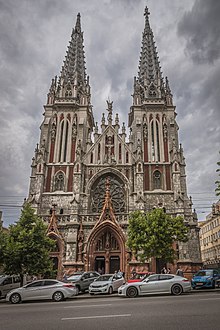St. Nicholas Roman Catholic Church, Kyiv
| Roman Catholic Church of St. Nicholas | |
|---|---|
 Church façade | |
| Religion | |
| Affiliation | Roman Catholic Church |
| Province | Kyiv |
| Region | Eastern Europe |
| Rite | Latin Rite |
| Status | Active |
| Location | |
| Location | vulytsia Velyka Vasylkivska, Pechersk Raion, Kyiv |
| State | Ukraine |
| Architecture | |
| Architect(s) | Władysław Horodecki |
| Style | Gothic Revival |
| Completed | 1909 |
| Specifications | |
| Direction of façade | West |
| Height (max) | 60 m (197 ft) |
| Spire(s) | 2 |
| Website | |
| Official website | |

The Roman Catholic Church of St. Nicholas (Template:Lang-uk, translit.: Kostel Sviatoho Mykolaia; Template:Lang-pl) is the second oldest Roman Catholic church standing in Kyiv, the capital of Ukraine after the St. Alexander Roman Catholic Cathedral. Today the building is shared between the Roman Catholic Church of Ukraine and the National House of Organ and Chamber Music.
It was constructed in 1899–1909 and was built by the Latin Rite Catholic community in a Gothic type construction, by Kyiv architects Władysław Horodecki and Emilio Sala.[1] It stands at vulytsia Velyka Vasylkivska (Greater Vasylkiv street) in Pechersk Raion next to the Kyiv National Linguistic University between the National Sports Complex Olimpiysky and the Railroad station Kyiv-Tovarny.
History
The church was constructed to accommodate the expanding Polish community, which more than doubled in size between 1897 and 1909.[2] The building permission was obtained thanks to the efforts of Count Władysław Branicki.[3]
A design competition held in 1898 selected Stanisław Wołowski, whose entry was a Gothic type construction with two 60 m (197 ft) towers. The final revision and management of the project was assigned to the Polish architect Władysław Horodecki.[1][4] Emilio Sala added sculptural decoration in artificial stone to the construction. To increase the stability of the construction on the uneven Kyiv ground, it was ensured by bore-and-stuffed piles, a newly introduced invention of Anton Strauss.[1] The construction work was carried out by exclusively from voluntary donations, and lasted for ten years (1899–1909).
In 1909, the church was consecrated in the name of Saint Nicholas, however the construction was not yet completed. A Gothic style three-story house was built for the parish clergy to the left of the church. In 1938, Soviet authorities closed the church after its Roman Catholic priest was "absent" for two years due to the Soviet persecution of Christians. For some time after its closure, the building was used by the punitive organs for technical purposes, and, at some point, served as a KGB service building.[5] After its restoration in 1979-1980, commissioned by the Rada of Ministers of the Ukrainian SSR, by the architects O. Grauzhis and I. Tukalevskiy, the church was turned into the National House of Organ and Chamber Music of Ukraine (Template:Lang-uk; translit.: Natsional'nyi budynok orhannoyi ta kamernoi muzyky Ukrainy). For the reconstruction and restoration of the severely damaged church, the building's stained glass windows were manufactured in the Baltics, its furniture was created in Lviv, and the high-quality wood floors were produced in the Ivano-Frankivsk Oblast.[1] The company, Rieger–Kloss then located in Czechoslovakia (Sudetenland), manufactured an organ for the church. Its manufacturer tried to architecturally tie the organ to the building itself.
Since 1992, Catholic Masses and concerts have been held here. Bishop Jan Purwinski consecrated the church and a Mass was celebrated there on 4 January 1992. Currently, it belongs to the Kyivan Municipal Department for Culture, but the Roman Catholic Church hopes it will be returned to the local Latin rite Roman Catholic community.[1] The Kyiv city municipality refuse to hand over the building until the issue of transferring the House of Organ Music will be solved. Since 2009 the building is in emergency conditions.
The religious services are performed by priests of the Missionary Oblates of Mary Immaculate. Most of the services are conducted in the Ukrainian language, while on some days services conducted in Polish, Latin and in Spanish.[6]
References
- ^ a b c d e Malikenaite, Ruta (2003). guidebook: Touring Kyiv. Kyiv: Baltia Druk. p. 131. ISBN 966-96041-3-3.
- ^ Michael F. Hamm (1996). Kiev: A Portrait, 1800–1917. Princeton University Press. pp. 78–79. ISBN 978-1-4008-5151-5.
- ^ Małysiak, Helena (1986). Biblioteka Branickich i Tarnowskich w Suchej (in Polish). BTSK. p. 36. ISBN 9788370040499.
- ^ Magocsi, Paul R. (2010). History of Ukraine: The Land and Its Peoples. University of Toronto Press. p. 357. ISBN 9781442610217.
- ^ Anisimov, Aleksandr (2002). Kyiv and Kyivans (in Russian). Kurch. pp. 88–89. ISBN 966-96120-1-2.
- ^ "St. Nicolas Cathedral". nicolasparish.org.ua (in Ukrainian). Retrieved 20 February 2020.
External links
- Official website (in Ukrainian)
- The National House of Organ and Chamber Music of Ukraine — official website (in Ukrainian)
